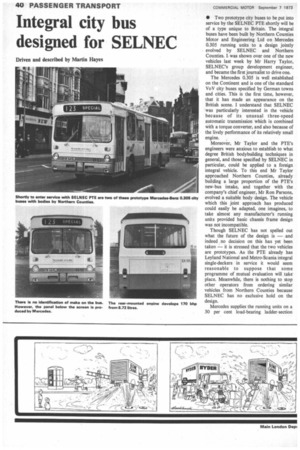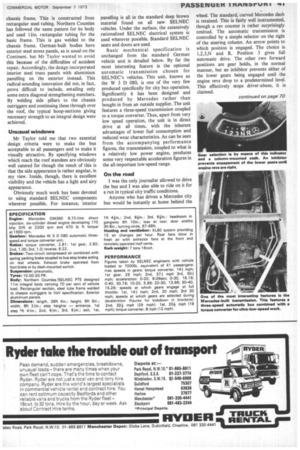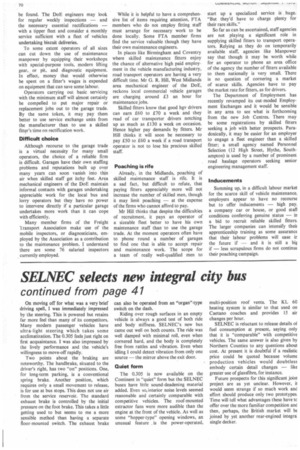Integral city bus designed for SELNEC
Page 42

Page 43

Page 72

If you've noticed an error in this article please click here to report it so we can fix it.
• Two prototype city buses to be put into service by the SELNEC PTE shortly will be of a type unique to Britain. The integral buses have been built by Northern Counties Motor and Engineering Ltd on Mercedes 0.305 running units to a design jointly evolved by SELNEC and Northern Counties. I was shown over one of the new vehicles last week by Mr Harry Taylor, SELNEC's group development engineer, and became the first journalist to drive one.
The Mercedes 0.305 is well established on the Continent and is one of the standard VoV city buses specified by German towns and cities. This is the first time, however, that it has made an appearance on the British scene. I understand that SELNEC was particularly interested in the vehicle because of its unusual three-speed automatic transmission which is combined With a torque converter, and also because of the lively performance of its relatively small engine.
Moreover, Mr Taylor and the PTE's engineers were anxious to establish to what degree British bodybuilding techniques in general, and those specified by SELNEC in particular, could be applied to a foreign integral vehicle. To this end Mr Taylor approached Northern Counties, already building a large proportion of the PTE's new-bus intake, and together with the company's chief engineer, Mr Ron Parsons, evolved a suitable body design. The vehicle which this joint approach has produced could easily be adapted, one imagines, to take almost any manufacturer's running units provided basic chassis frame design was not incompatible.
Though SELNEC has not spelled out what the future of the design is — and indeed no decision on this has yet been taken — it is stressed that the two vehicles are prototypes. As the PTE already has Leyland National and Metro-Scania integral single-deckers in service it would seem reasonable to suppose that some programme of mutual evaluation will take place. Meanwhile, there is nothing to stop other operators from ordering similar vehicles from Northern Counties because SELNEC has no exclusive hold on the design.
Mercedes supplies the running units on a 30 per cent load-bearing ladder-section chassis frame. This is constructed from rectangular steel tubing. Northern Counties has followed the same pattern for its body and used 1-1-in. rectangular tubing for the basic frame. This is gas welded to the chassis frame. German-built bodies have exterior steel stress panels, as is usual on the Continent. but Mr Taylor wanted to avoid this because of the difficulties of accident repair. Accordingly, the design incorporated interior steel truss panels with aluminium panelling on the exterior instead. This radical-sounding innovation did not, in fact, prove difficult to include, entailing only some extra diagonal strengthening members. By welding side pillars to the chassis outriggers and continuing these through over the roof, the typical hoop-sections giving necessary strength to an integral design were achieved.
Unusual windows Mr Taylor told me that two essential design criteria were to make the bus acceptable to all passengers and to make it visually attractive. By specifying windows which reach the roof standees are obviously well catered for though the result of this is that the side appearance is rather angular, in my view. Inside. though, there is excellent visibility and the vehicle has a light and airy appearance.
Obviously much work has been devoted to using standard SELNEC components wherever possible. For instance, interior panelling is all in the standard deep brown material found on all new SELNEC vehicles. Under the surface, the extensively rationalized SELNEC electrical system is used wherever possible. Standard SELNEC seats and doors are used.
Basic mechanical specification is unchanged from the standard German vehicle and is detailed below. By far the most interesting feature is the optional automatic transmission chosen for SELNEC's vehicles. This unit, known as the W 3 D 080, is one of the very few produced specifically for city bus operation. Significantly it has been designed and produced by Mercedes rather than bought-in from an outside supplier. The unit features a three-speed transmission coupled to a torque converter. Thus, apart from very low speed operation, the unit is in direct drive at all times, with the inherent advantages of lower fuel consumption and reduced wear characteristics. As can be seen from the accompanying performance figures, the transmission. coupled to what is a relatively low power engine, produces some very respectable acceleration figures in the all-important low-speed range.
On the road I was the only journalist allowed to drive the bus and I was also able to ride on it for a run in typical city traffic conditions.
Anyone who has driven a Mercedes city bus would be instantly at home behind the wheel. The standard, curved Mercedes dash is retained. This is fairly well instrumented, though a rev counter is rather surprisingly omitted. The automatic transmission is controlled by a simple selector on the right of the steering column. An arrow points to which position is engaged. The choice is 1,2.3,N and R. Position 3 gives full automatic drive. The other two forward positions are gear holds, in the normal manner, but an inhibitor prevents either of the lower gears being engaged until the engine revs drop to a predetermined level. This effectively stops driver-abuse, it is claimed.
On moving off for what was a very brief driving spell, I was immediately impressed by the steering. This is powered but retains far more feel than many of its competitors. Many modern passenger vehicles have ultra-light steering which takes some acclimatization. The 0.305 feels just right on first acquaintance. I was also impressed by the lively performance and the vehicle's willingness to move-off rapidly.
Two points about the braking are noteworthy. The handbrake, situated to the driver's right, has two "on" positions. One, for long-term parking, is a conventional spring brake. Another position, which requires only a small movement to release, is for use at bus stops. This does not use air from the service reservoir. The standard exhaust brake is controlled by the initial pressure on the foot brake. This takes a little getting used to but seems to me a more sensible method than having a separate floor-mounted switch. The exhaust brake can also be operated from an "organ"-type switch on the dash.
Riding over rough surfaces in an empty vehicle is always a good test of both ride and body stiffness. SELNEC's new bus came out well on both counts. The ride was well damped with minimal roll, even when cornered hard, and the body is completely free from rattles and vibration. Even when idling I could detect vibration from only one source — the mirror above the exit door.
Quiet form The 0.305 is now available on the Continent in "quiet" form but the SELNEC buses have little sound-deadening material added. Even so, interior noise levels seemed reasonable and certainly comparable with competitive vehicles. The roof-mounted extractor fans were more audible than the engine at the front of the vehicle. As well as some "hopper-type" opening windows, an unusual feature is the power-operated, multi-position roof vents. The KL 60 heating system is similar to that used on Caetano coaches and provides 15 air changes per hour.
SELNEC is reluctant to release details of fuel consumption at present, saying only that it is "comparable" with competitive vehicles. The same answer is also given by Northern Counties to any questions about cost. At present it is doubtful if a realistic price could be quoted because volume production vehicles would doubtless embody certain detail changes — like greater use of glassfibre, for instance.
Future prospects for this significant joint project are as yet unclear_ However, it would seem strange if so much work and effort should produce only two prototypes, Time will tell what advantages these have tc offer over the more familiar competition and then, perhaps, the British market will be joined by yet another rear-engined integra single decker.








































































































































